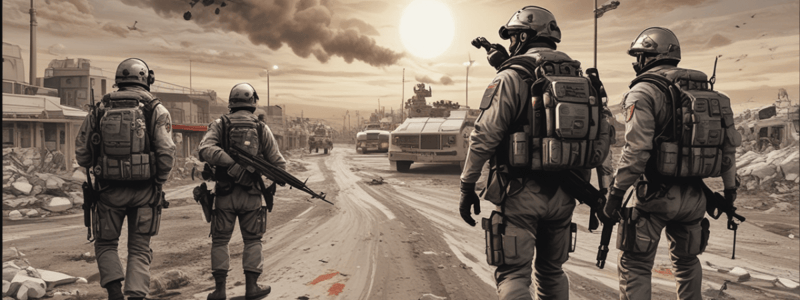Podcast
Questions and Answers
What is the primary goal of international terrorism?
What is the primary goal of international terrorism?
- To further ideological causes relevant to national issues
- To achieve violent religious or political goals
- To promote peaceful coexistence among nations
- To intimidate or coerce a civilian population, influence policy, or affect a government (correct)
According to the US Department of Justice, what is a key characteristic of terrorism?
According to the US Department of Justice, what is a key characteristic of terrorism?
- Peaceful negotiations and diplomacy
- Economic sanctions and trade embargoes
- Acts involving violence or danger to human life (correct)
- Non-violent protests and demonstrations
What type of terrorism is committed by people hoping to further ideological causes relevant to national issues?
What type of terrorism is committed by people hoping to further ideological causes relevant to national issues?
- Cyber terrorism
- Single-issue terrorism
- International terrorism
- Domestic terrorism (correct)
What is the primary challenge of predicting lone wolf attacks?
What is the primary challenge of predicting lone wolf attacks?
What is the primary emphasis of the Hartford Consensus in responding to active shooter events?
What is the primary emphasis of the Hartford Consensus in responding to active shooter events?
What is the pneumonic used to remember the principles of response to active shooter events?
What is the pneumonic used to remember the principles of response to active shooter events?
What is the primary goal of weapons of mass destruction?
What is the primary goal of weapons of mass destruction?
What type of weapons have terrorist groups attempted to use unsuccessfully?
What type of weapons have terrorist groups attempted to use unsuccessfully?
What is the primary effect of biologic agents?
What is the primary effect of biologic agents?
What is a crucial aspect of scene safety during a WMD response?
What is a crucial aspect of scene safety during a WMD response?
What is the primary method of protection from WMD agents?
What is the primary method of protection from WMD agents?
What is the purpose of staging a vehicle at a safe distance from the incident?
What is the purpose of staging a vehicle at a safe distance from the incident?
Study Notes
-
Terrorism poses a threat to nations and cultures everywhere, and the US Department of Justice defines it as an act involving violence or danger to human life, intended to intimidate or coerce a civilian population, influence policy, or affect a government.
-
International terrorism is committed by people associated with or inspired by a defined terrorist organization or nation, while domestic terrorism is committed by people hoping to further ideological causes relevant to national issues.
-
Only a small percentage of groups turn to terrorism, including violent religious groups, doomsday cults, extremist political groups, violent separatist groups, cyber terrorists, and single-issue groups.
-
Domestic terrorism trends include lone wolf attacks, which are difficult to predict and have been devastating in recent years, such as the 2015 Emmanuel Church shooting, 2016 Pulse Nightclub shooting, and 2017 Las Vegas shooting.
-
The Hartford Consensus provides recommendations for responding to active shooter events, including threat suppression, hemorrhage control, rapid extrication, and transport to definitive care, with an emphasis on early hemorrhage control and re-evaluation.
-
The pneumonic "THREAT" is used to remember the principles of response: threat suppression, hemorrhage control, rapid extrication, assessment by medical providers, and transport to definitive care.
-
Weapons of mass destruction (WMDs) are designed to bring about mass death, casualties, and damage to property and infrastructure, and can be biological, nuclear, incendiary, chemical, or explosive.
-
Terrorist groups have favored tactics using explosive devices, and attempts to use chemical or biological weapons have been unsuccessful.
-
Chemical agents are manufactured substances that can have devastating effects on living organisms, and biologic agents cause disease through viruses, bacteria, and toxins.
-
Radiologic or nuclear terrorism is possible, with nations holding close ties with terrorist groups and obtaining nuclear capabilities.
-
Indicators for a terrorist event include the type of location, number of patients, patient statements, and pre-incident indicators, and responders should be aware of their surroundings and possible risks.
-
Responders should stage their vehicle at a safe distance from the incident, wait for law enforcement to secure the scene, and establish a staging area where trained responders in appropriate PPE can handle the WMD incident.
-
Protection from WMD agents involves preventing contact with the agent, and responders should inform dispatch of the event, additional resources required, and the estimated number of patients.
-
Scene safety is crucial, with terrorists known to plant additional explosives to injure responders and secure media coverage, and responders should constantly reassess scene safety.
Studying That Suits You
Use AI to generate personalized quizzes and flashcards to suit your learning preferences.
Description
This quiz covers the definition and types of terrorism, including international and domestic terrorism, as well as response strategies to terrorist events, including active shooter incidents and weapons of mass destruction. Learn about the indicators of a terrorist event, how to respond safely, and the importance of scene safety. Discover the different types of weapons of mass destruction and how to prevent contact with them.




